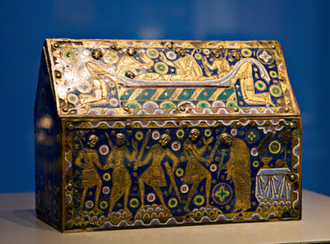Exhibition: Thomas Becket: Murder and the Making of a Saint

Limoge enamelled reliquary 1210
Coronavirus delayed The British Museums' landmark exhibition marking the 850th anniversary of St Thomas Becket's death last year...
At the recent opening, lack of social distancing was disconcerting. Over 100 fascinating and rare artefacts are displayed, enhanced by a dramatic silhouetted representation of the murder in Canterbury Cathedral. A video digitally reconstructs the bejewelled shrine venerated by Medieval pilgrims and overseen by Benedictine monks.
Born in Cheapside, London circa 1120 to Norman mercantile parents, Thomas was educated at Merton Priory and Paris. He found employment as a clerk to Theobald, Archbishop of Canterbury in 1155. His charm and intelligence led to Theobald suggesting to King Henry 11 that Becket be appointed as his Chancellor. He accompanied Henry around the country, enjoying courtly pursuits such as hunting , gaming and chess. He enjoyed an ostentatious lifestyle and undertook diplomatic missions overseas for the king.
When Theobald died Henry proposed his friend as the new Archbishop of Canterbury. Becket was now an Archdeacon but the suggestion caused controversy.
Thomas was ordained priest the day before his Episcopal consecration. He seemingly underwent a Damascene conversion following his consecration as Primate. Contemporaries wrote that "he was transformed ,....and put on the new man in righteousness and sanctity."
He resigned as Chancellor to Henry's chagrin who'd hoped to gain power over the church. They became embroiled in a dispute concerning authority over ecclesiastical and secular courts.
Plantagenet kings were often in dispute with their Primate and Becket spent six years in exile in France. Wonderful illustrated manuscripts vividly portray these scenes.
There had been complex dynastic disputes over the monarchy before Henry II and he decided to have his eldest son crowned in England in Becket's absence whilst retaining power, ruling from Normandy. Becket excommunicated the Archbishop of York who conducted the ceremony, as well as the Bishops' of London and Salisbury.
Thomas returned to England to great popular acclaim in December 1170 following Papal pressure on Henry, who was enraged at the Bishops' expulsion.
Four knights thought he wished to be rid of Becket. They travelled to Canterbury to arrest Thomas who sought sanctuary in the cathedral where he was killed at the altar. Within days of his murder, extraordinary miracles were reported. These are vividly depicted in Canterbury Cathedral's 13th century Miracle window at the centre of the exhibition. Viewing the stained glass at eye level is breathtaking.
Becket was canonised in 1173.
Henry II made pilgrimages to Canterbury and did penance, adopting St Thomas as his patron. Displayed is the charter he granted to the shrine in 1174. Devotion to Becket rapidly spread throughout Europe.
An unusual Swedish font carved in 1191 depicts the murder. Canterbury became one of the most popular pilgrimage destinations until 1538 when Henry VIII ordered its destruction and the removal of Becket's name and image from books and churches.
Disturbing images of psalters with pages obliterated have modern parallels; red ink splattered over a missal inadvertently resembles a martyrs' blood .
Rare manuscripts bearing the seals of Henry and Becket are displayed.
Remarkably fingerprints have just been discovered on Becker's seal that might be those of the saint.
Stunning enamelled reliquaries illustrate these events. Pilgrim badges, multifarious souvenirs- including miniature replicas of the sword that killed Becket, alongside bovine bone skates are fascinating.
A beautiful gold pendant bearing an image of Thomas as Archbishop with John the Baptist on the reverse is inscribed, "At my end "in Norman French.
Reliquary jewels belonging to St Thomas More and a medal depict both St Thomas Becket and him, linking their martyrdoms.
Near the exit is a silver figure of Becket with a sword in his head, made in in 1666 for the Jesuits of St.Omer. Alongside this, wrapped in red velvet is a piece of his skull encased in an intricate reliquary which was originally affixed to the effigy .
A quote from TS Eliot's Murder in the Cathedral, is inscribed on the wall above.
"....wash the stone, wash the bone........wash the soul......"
There are some myths perpetuated on the website and in the catalogue in an otherwise riveting and splendid exhibition. John Bale was a former Carmelite friar - not a monk. Catholics have never worshipped saints or remains. - they VENERATE them.
Saints are not divinised but SANCTIFIED and the blood of a martyr has always been seen as salvific.
The Exhibition Thomas Becket: Murder and the Making of a Saint runs until 23 August 2021.
Admission charges. Concessionary rates
For further information see: www.britishmuseum.org/becket


















